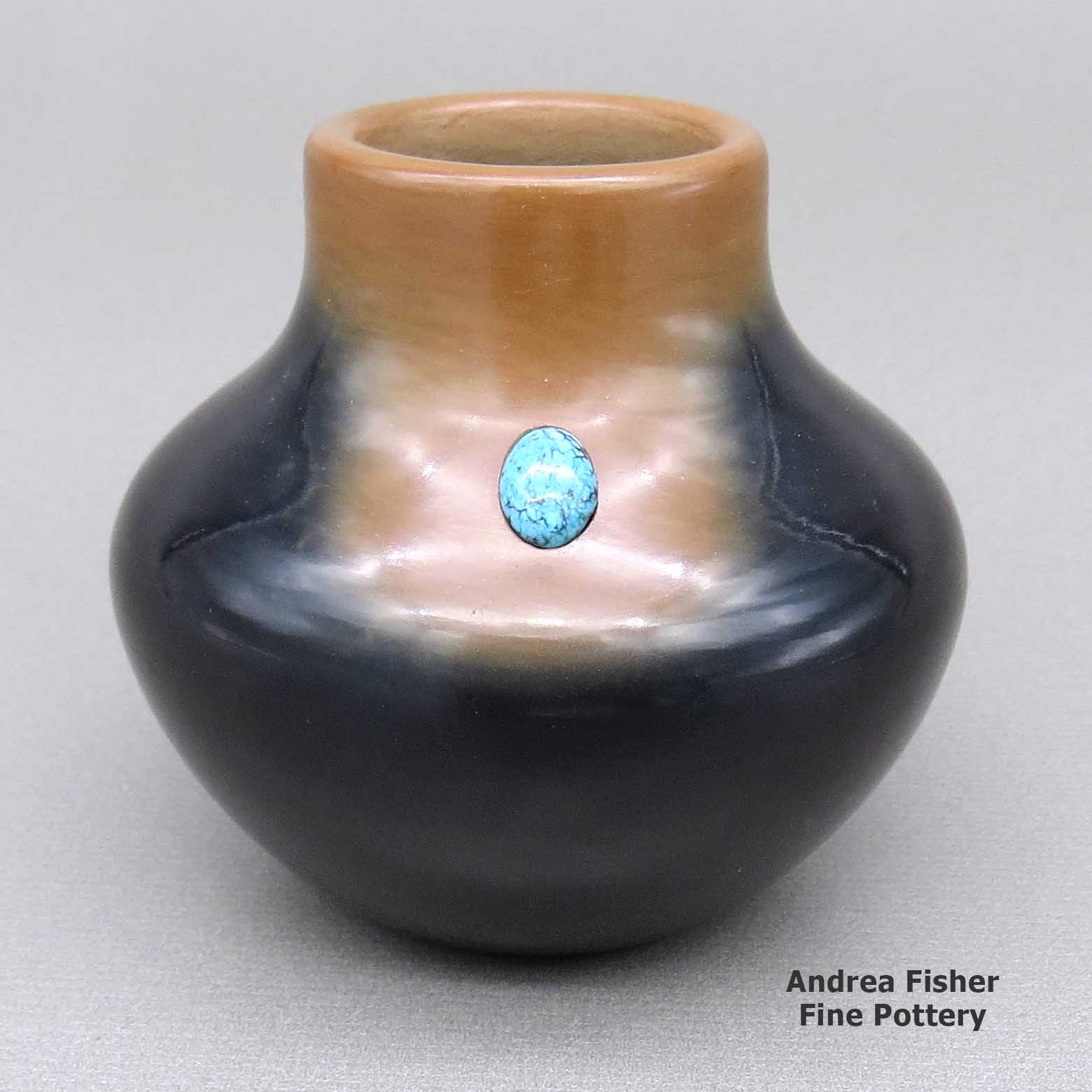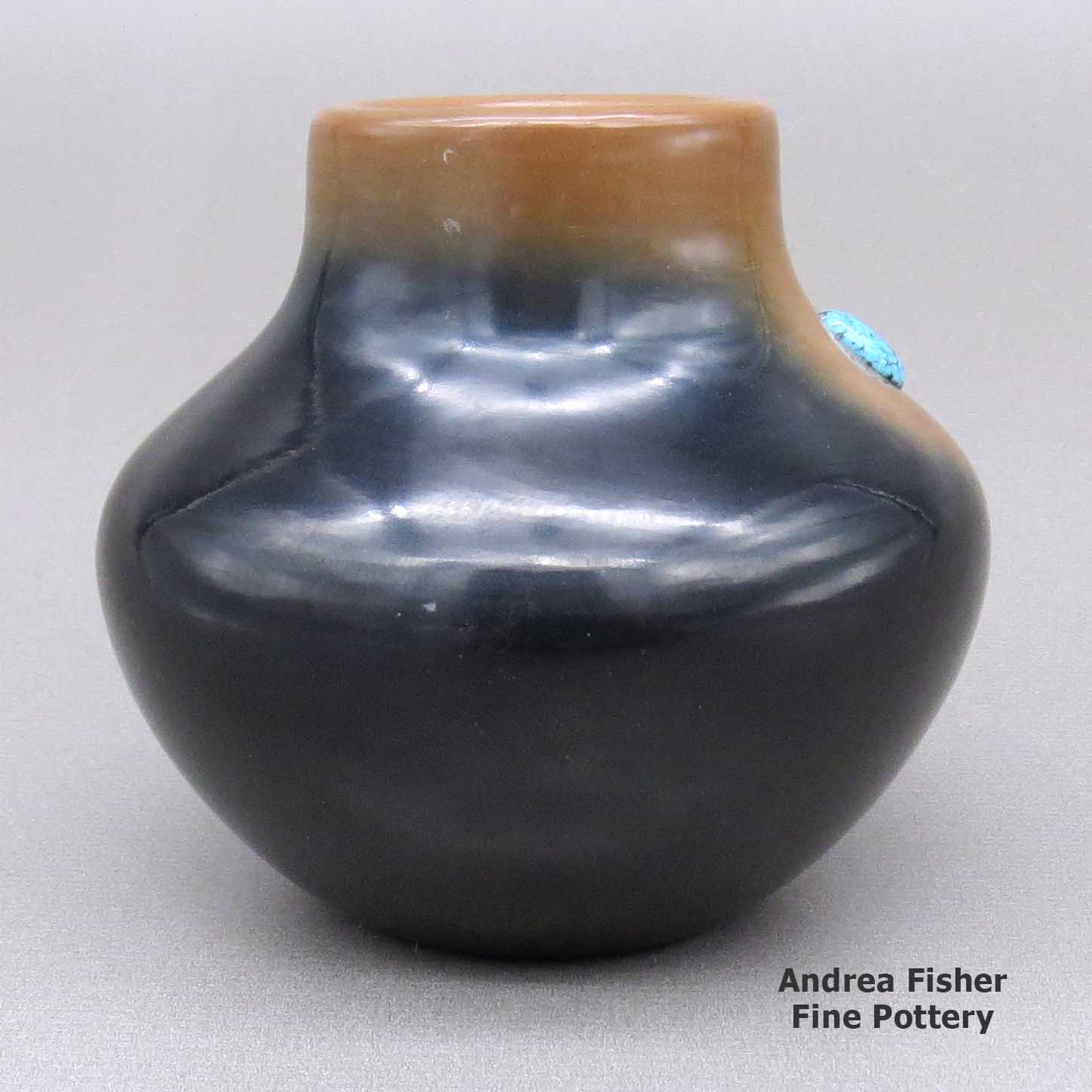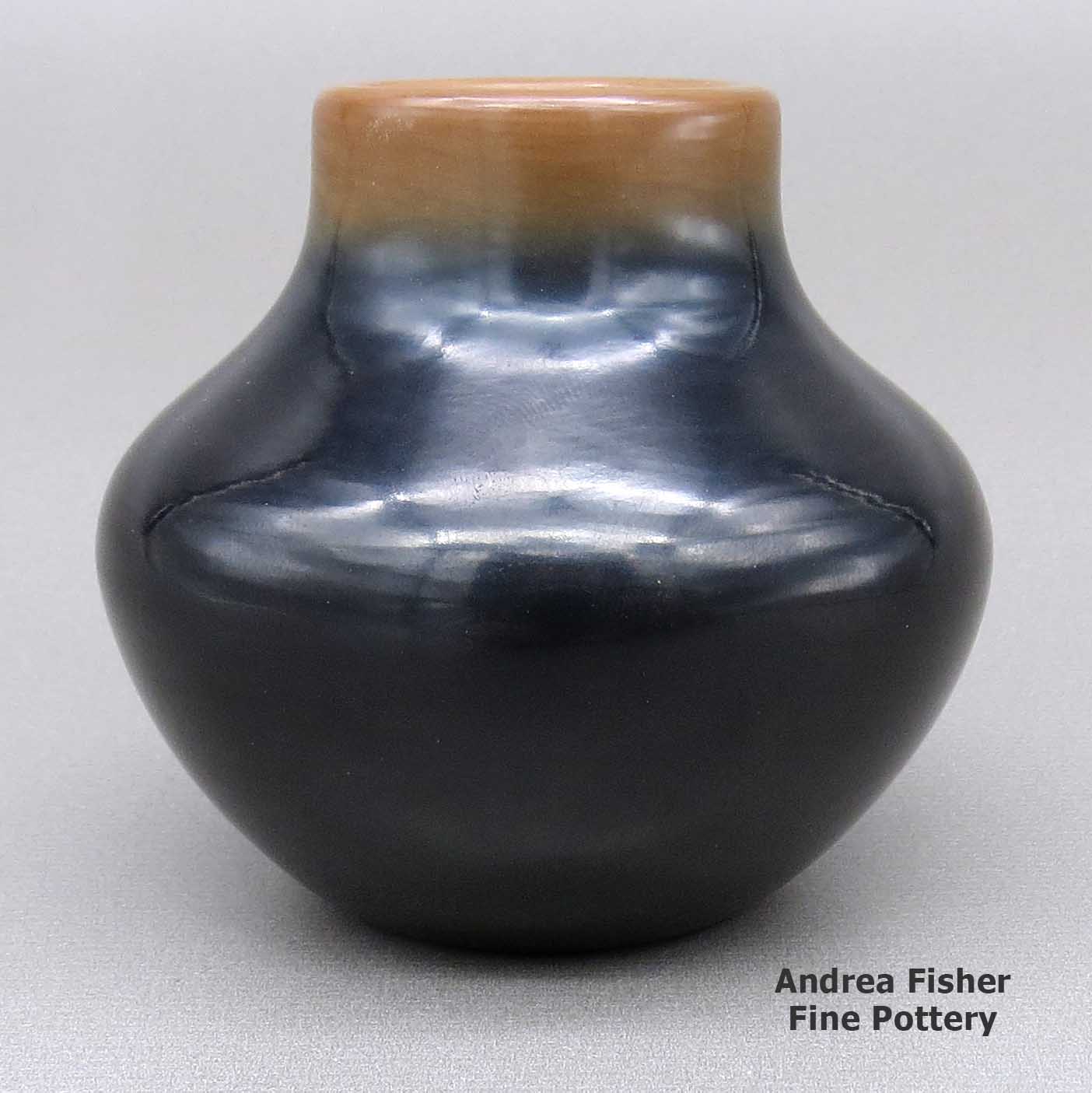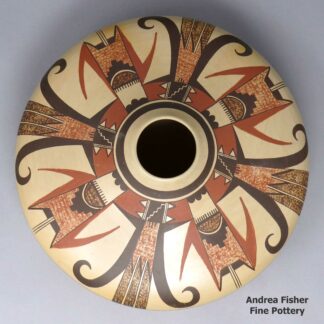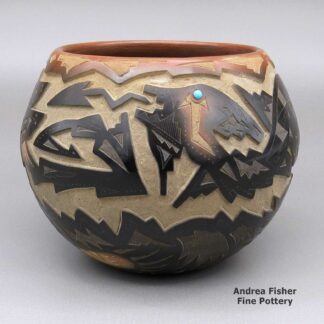| Dimensions | 2.75 × 275 × 2.75 in |
|---|---|
| Condition of Piece | Very good |
| Date Born | 1991 |
| Signature | Dora of San Ildefonso |
Dora Tse Pe, dksi3c235, Jar with a sienna spot and rim
$725.00
A small black jar with a sienna spot and rim plus an inlaid turquoise detail
In stock
Brand
Tse Pe, Dora
Dora Gachupin was born into Zia Pueblo in 1939 to parents Candelaria Medina of Zia Pueblo and Tony Gachupin of Jemez Pueblo. She married Johnnie "Tse-Pe" Gonzales of San Ildefonso Pueblo in 1961 and, contrary to the ancient tradition, she moved to his home from Zia (the Pueblo people are generally matrilineal: home is usually where the wife's family is).
Dora had grown up learning the Zia pottery designs and shapes but she was also used to Zia clay and using crushed basalt as a tempering agent. At San Ildefonso, Dora was exposed to the highly polished red and black wares that Rose Gonzales, her mother-in-law (of San Juan lineage), was making. The clay, the slips and the tempering agents were quite different. "We didn't polish at Zia", Dora has said, "we used slips and plant and mineral paints." It was from Rose that she learned polishing, carving and other San Ildefonso and San Juan styles and techniques.
Other exceptional potters who have influenced Dora over the years include Popovi Da with his two-tone black and sienna ware and Tony Da with his exquisite sgraffito work and his use of stone inlays.
Dora’s work often includes turquoise, coral or onyx inlays on pots that also include combinations of black and sienna with micaceous slips. Her innovative style has sometimes been called "contemporary" and she often works with both polished clay and dull or micaceous clays in the same piece. However, she says she doesn't like that "contemporary" term and considers herself and her work to be traditional.
She earned many awards over the years, including Best in Traditional Pottery and Master Potter at Santa Fe Indian Market. Dora believes in quality not quantity and sees her art to be a gift from God. "It gives me pleasure to create beauty from the earth," she says. "Also to know that long after I've served my time on this earth, the pots I've created will live on."
Some Exhibits that featured Dora's work
- Choices and Change: American Indian Artists in the Southwest. Heard Museum North Scottsdale. Opened June 30, 2007
- Recent Acquisitions from the Herman and Claire Bloom Collection. Heard Museum. Phoenix, AZ January 11, 1997 - July 31, 1997
- Fifth Annual Hollywood Premiere. Four Seasons Hotel, Los Angeles, CA. Gallery 10. Scottsdale, AZ. November 23, 1991 - November 24, 1991
- Magic in Clay. Morrill Hall, University of Nebraska State Museum. Lincoln, NE. May 5, 1991 - August 30, 1991
- 1976 Heard Museum Guild Indian Arts and Crafts Exhibit. Heard Museum. Phoenix, Arizona. November 26 - December 5, 1976
Some Awards Dora earned
- 2009 Heard Museum Guild Indian Fair & Market: Judge's Choice Award
- 2007 Heard Museum Guild Indian Fair & Market, Class. II - Pottery, Division B - Traditional, native clay, hand built, unpainted: First Place
- 2007 Heard Museum Guild Indian Fair & Market, Judge's Choice Award
- 1976 Heard Museum Guild Indian Arts and Crafts Exhibit, Classification X - Pottery, Division C - Figurines, bells, jewelry, miniatures, etc.: Second Place. Awarded for artwork: Miniature vase
- 1976 Heard Museum Guild Indian Arts and Crafts Exhibit, Classification X - Pottery, Division C - Figurines, bells, jewelry, miniatures, etc.: Honorable Mention. Awarded for artwork: Turtle with etched serpent
A Short History of San Ildefonso Pueblo
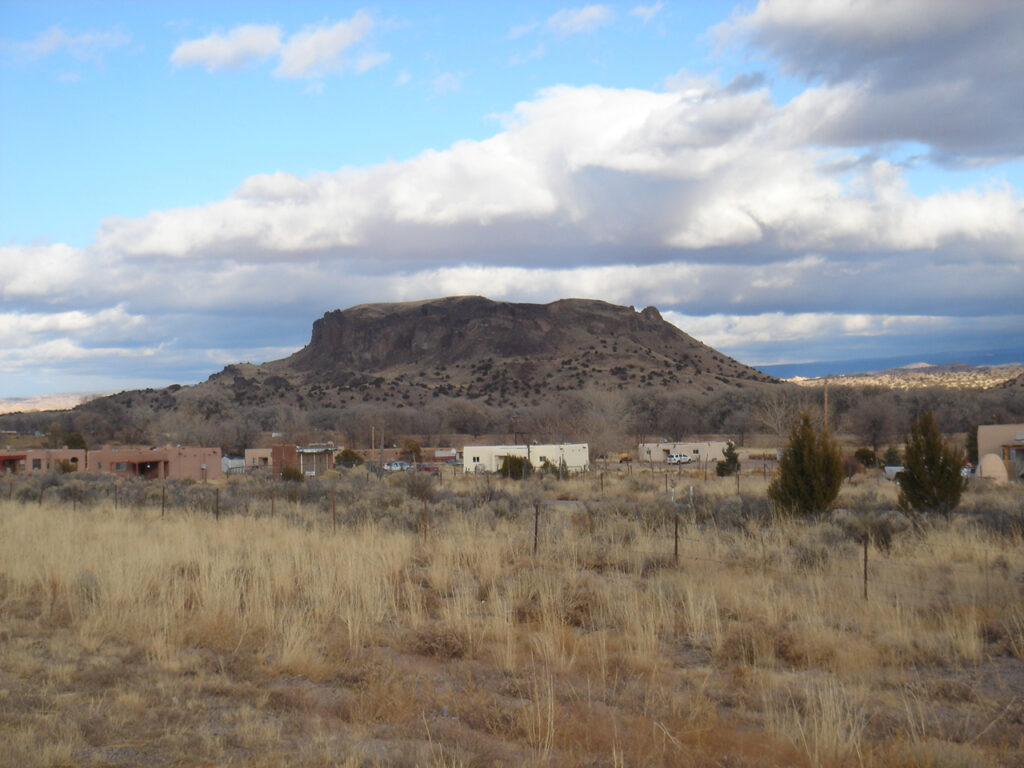
San Ildefonso Pueblo is located about twenty miles northwest of Santa Fe, New Mexico, mostly on the eastern bank of the Rio Grande. Although their ancestry has been traced as far back as abandoned pueblos in the Mesa Verde area in southwestern Colorado, the most recent ancestral home of the people of San Ildefonso is in the area of Bandelier National Monument, the prehistoric village of Tsankawi in particular. The area of Tsankawi abuts today's reservation on its northwest side.
The San Ildefonso name was given to the village in 1617 when a mission church was established. Before then the village was called Powhoge, "where the water cuts through" (in Tewa). The village is at the northern end of the deep and narrow White Rock Canyon of the Rio Grande. Today's pueblo was established as long ago as the 1300s and when the Spanish arrived in 1540 they estimated the village population at about 2,000.
That first village mission was destroyed during the Pueblo Revolt of 1680 and when Don Diego de Vargas returned to reclaim the San Ildefonso area in 1694, he found virtually the entire tribe on top of nearby Black Mesa, along with almost all of the Northern Tewas from the various pueblos in Tewa Basin. After an extended siege, the Tewas and the Spanish negotiated a treaty and the people returned to their villages. However, the next 250 years were not good for any of them.
The Spanish swine flu pandemic of 1918 reduced San Ildefonso's population to about 90. The tribe's population has increased to more than 600 today but the only economic activity available for most on the pueblo involves the creation of art in one form or another. The only other jobs are off-pueblo. San Ildefonso's population is small compared to neighboring Santa Clara Pueblo, but the pueblo maintains its own religious traditions and ceremonial feast days.

Photo is in the public domain
About Jars
The jar is a basic utilitarian shape, a container generally for cooking food, storing grain or for carrying and storing water. The jar's outer surface is a canvas where potters have been expressing their religious visions and stories for centuries.
In Sinagua pueblos (in northern Arizona), the people made very large jars and buried them up to their openings in the floors of the hidden-most rooms in their pueblo. They kept those jars filled with water but also kept smaller jars of meat and other perishables inside those jars in the water. It's a form of refrigeration still in use among indigenous people around the world.
Where bowls tend to be low, wide and with large openings, jars tend to be more globular: taller, less wide and with smaller openings.
For a potter looking at decorating her piece, bowls are often decorated inside and out while most jars are decorated only on the outside. Jars have a natural continuity to their design surface where bowls have a natural break at the rim, effectively yielding two design surfaces on which separate or complimentary stories can be told.
Before the mid-1800s, storage jars tended to be quite large. Cooking jars and water jars varied in size depending on how many people they were designed to serve. Then came American traders with enameled metal cookware, ceramic dishes and metal eating utensils...Some pueblos embraced those traders immediately while others took several generations to let them and their innovations in. Either way, opening those doors led to the virtual collapse of utilitarian pottery-making in most pueblos by the early 1900s.
In the 1920s there was a marked shift away from the machinations of individual traders and more toward marketing Native American pottery as an artform. Maria Martinez was becoming known through her exhibitions at various major industrial fairs around the country and Nampeyo of Hano was demonstrating her art for the Fred Harvey Company at the Grand Canyon. The first few years of the Santa Fe Indian Market helped to solidify that movement and propel it forward. It took another couple generations of artists to open other venues for their art across the country and turn Native American art into the phenomenon it has become.
Today's jars are artwork, not at all for utilitarian purposes, and their shapes, sizes and decorations have evolved to reflect that shift.
About Inlays
Inlays are a relatively recent development in the world of Native American pottery. To make an inlay, it is necessary to carve a close-fitting groove or notch on a piece in which to set the inlay. Then the piece is fired and once cooled, whatever the inlay material is, it is glued in place.
Often, the inlay is composed of a cabuchon of turquoise or other semi-precious stone, or perhaps a piece of coral. Sometimes it is a strand (or strands) of heishe beads. Sometimes it is a small piece of sculpted silver, like Preston Duwyenie's Shifting Sands designs.
Ramona Gonzales Family Tree - San Ildefonso Pueblo
Disclaimer: This "family tree" is a best effort on our part to determine who the potters are in this family and arrange them in a generational order. The general information available is questionable so we have tried to show each of these diagrams to living members of each family to get their input and approval, too. This diagram is subject to change should we get better info.
-
Ramona Sanchez Gonzales (1885-), second wife of Juan Gonzales (painter)
- Rose (Cata) Gonzales (daughter-in-law)(1900-1989)(San Juan) & Robert Gonzales (1900-1935)
- (Johnnie) Tse-Pe (Gonzales)(1940-2000) & Dora Tse-Pe (Gachupin, first wife, Zia, 1939-)
- Andrea Tse Pe (1975-)
- Candace Tse-Pe (1968-)
- Gerri Tse-Pe (1963-)
- Irene Tse-Pe (1961-)
- Jennifer Tse-Pe (1966-1983)
- (Johnnie) Tse-Pe (1940-2000) & Jennifer Tse Pe (Sisneros - second wife, Santa Clara)
- Marie Gonzales-Kailahi & James Kailahi
- (Johnnie) Tse-Pe (Gonzales)(1940-2000) & Dora Tse-Pe (Gachupin, first wife, Zia, 1939-)
- Blue Corn (Crucita Gonzales Calabaza)(1921-1999)(step-daughter of Ramona) & Santiago Calabaza (Santo Domingo) (d. 1972)
- Heishi Flower (Diane Calabaza-Jenkins) (1955-)
- Joseph Calabaza (Tha Mo Thay)
- Elliott Calabaza
- Lucille Calabaza-King
- Nancy Calabaza
- Sophia Calabaza
- Stacey Calabaza
- Krieg Kalavaza
- Vera Solomon (Laguna)
Rose' students: - Juanita Gonzales (1909-1988) & Louis Wo-Peen Gonzales (brother of Rose Gonzales husband)
- Adelphia Martinez (1935- )
- Lorenzo Gonzales (1922-1995)(adopted by Louis & Juanita) & Delores Naquayoma (Hopi/Winnebago)
- Jeanne M. Gonzales (1959-)
- John Gonzales (1955-)
- Laurencita Gonzales
- Linda Gonzales
- Marie Ann Gonzales
- Raymond Gonzales
- Robert Gonzales (1947-) & Barbara Tahn-Moo-Whe Gonzales (1947-)
- Aaron Gonzales (1971-)
- Brandon Gonzales (1983-)
- Cavan Gonzales (1970-)
- Derek Gonzales (1986-)
- Oqwa Pi (Abel Sanchez)(1899-1971) & Tomasena Cata Sanchez (Rose' sister) (1903-1985)
- Skipped generation
- Russell Sanchez (1966-)
- Skipped generation
